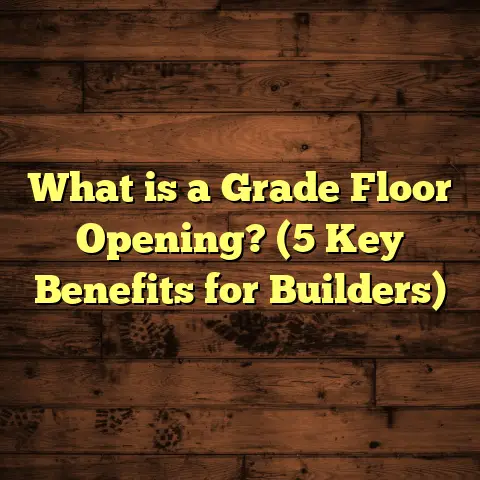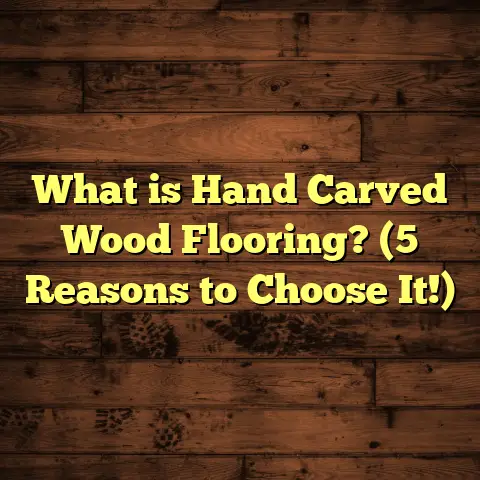What is Floor Maintenance? (5 Tips for Spotless Surfaces)
I still remember the day I finished installing hardwood floors
in a historic home downtown. The wood gleamed under the warm
afternoon sun, and the homeowners were thrilled to see their
vision come to life. But after the excitement settled, the real
work began—keeping those floors spotless and lasting for years.
That experience taught me a lot about floor maintenance, and I
want to share what I’ve learned with you in detail.
Floor maintenance is one of those topics that can seem simple
at first glance but quickly reveals its complexity when you
really get into it. Whether your floors are hardwood, tile, vinyl,
or carpet, knowing how to care for them properly saves time,
money, and frustration down the road.
What is Floor Maintenance?
Floor maintenance is the ongoing process of caring for your
flooring to keep it clean, safe, and visually appealing over time.
It’s more than just sweeping or mopping; it involves tailored
practices depending on the type of flooring material and the
environment where it’s installed.
Think of it like caring for your skin—you don’t just wash your
face once and expect it to stay fresh forever. You follow a routine
that suits your skin type, protects it from damage, and keeps it
healthy day after day. Floors need that kind of attention too.
Proper floor maintenance encompasses:
- Regular cleaning to remove dirt and debris
- Preventative measures to avoid damage from furniture, moisture, or heavy traffic
- Periodic inspections to catch early signs of wear or damage
- Timely repairs such as refinishing or replacing damaged sections
- Protective treatments like sealing grout or applying finishes
It’s about preserving the material and surface finish, preventing
wear and tear, and extending the life of your floors. When done
right, it can save you money by reducing the need for costly repairs
or replacement.
Why Floor Maintenance Is Often Overlooked
For many people, floor maintenance is an afterthought until an issue
arises—like scratches on hardwood or stains on carpet. From my
experience working with clients, a common reason is lack of clear
knowledge about what steps to take and why they matter.
Many assume that professional installation means floors will stay
perfect without much effort. Unfortunately, that’s not true. Every floor
needs care that matches its material and usage patterns.
Floors experience daily stress: foot traffic, moved furniture, pets, spills,
and environmental factors like humidity changes. Without proper care,
this stress accumulates fast.
Why Does Floor Maintenance Matter?
You might ask yourself, “Why should I bother with floor maintenance if my floors look fine now?” Well, I’ve seen plenty of floors that looked okay at first but ended up scratched, stained, or warped because they weren’t cared for properly.
Here’s a quick stat for you: According to a study by the National Wood Flooring Association (NWFA), well-maintained hardwood floors can last up to 100 years, while poorly maintained ones may only last 20-30 years. That’s a huge difference in value and durability.
Floors are one of the biggest investments in any building. They handle daily foot traffic, furniture movement, spills, and even environmental changes like humidity and temperature shifts. Without regular maintenance, these factors add up quickly.
Financial Impact of Neglecting Floor Maintenance
Let me share a story that underlines this point. A client once called me frustrated because their brand-new laminate flooring was peeling after just two years. Upon inspection, I realized they had been using harsh chemical cleaners and mopping excessively with water. The laminate wasn’t designed for such treatment.
Replacing the floor cost them over $4,000—far more than regular maintenance would have cost. This is common; neglect adds up financially. The International Floor Covering Association estimates that proper maintenance reduces flooring replacement costs by up to 50%.
Safety Considerations
Flooring in poor condition can also become a safety hazard. Cracked tiles or warped wooden planks create trip risks. Slippery surfaces from improper cleaning agents increase fall chances.
Maintaining floors means maintaining safety too—a key consideration in homes with kids or elderly residents.
Environmental Benefits
Maintaining flooring extends its lifespan and reduces waste. Flooring materials like hardwood or tile require resources and energy to produce. Replacing floors prematurely contributes to landfill waste and environmental strain.
By maintaining floors properly, you reduce your environmental footprint—a win-win for your home and the planet.
5 Tips for Spotless Surfaces
Let me walk you through five key tips that I use regularly on job sites and recommend to homeowners for keeping floors spotless and in top shape.
1. Choose the Right Cleaning Products
Not all cleaners are created equal. Using harsh chemicals or abrasive tools on delicate flooring can cause permanent damage.
For example:
- Hardwood floors need pH-neutral cleaners that don’t strip away the finish or dry out the wood.
- Tile floors might handle stronger detergents but require grout-safe options to avoid discoloration.
- Vinyl flooring benefits from mild soap-based cleaners.
- Carpets need specialized shampoos that don’t leave residues attracting dirt.
In one project, a client was using vinegar-based cleaners on their hardwood floors thinking it was natural and safe. Unfortunately, the acidity wore down the protective finish quickly. Switching them to a specialized hardwood cleaner made a noticeable difference in how the floors looked and felt after cleaning.
Pro tip: Always check with your flooring manufacturer’s guidelines before selecting cleaners.
How Do You Know What Cleaner to Use?
If you’re unsure what cleaner suits your floors:
- Look at product labels carefully.
- Ask your flooring installer or supplier.
- Test cleaners on a small hidden area first.
- Avoid anything labeled “abrasive” or with ammonia on wood surfaces.
The Risks of DIY Cleaning Solutions
I often get asked about homemade cleaning solutions. While some are safe when used sparingly (like diluted dish soap), others can cause harm:
- Vinegar’s acidity damages wood finishes.
- Bleach discolors grout and fibers.
- Oil-based soaps leave residues attracting dirt.
Stick to proven products designed for your floor type.
2. Regular Dusting and Sweeping Prevents Damage
Dust particles are tiny but tough enemies of floors. Over time, dirt and grit can act like sandpaper underfoot, scratching surfaces.
I tell clients to sweep or dust mop daily in high-traffic areas. It’s simple but effective. For carpets, vacuuming thoroughly twice a week reduces embedded dirt that damages fibers.
Using microfiber mops helps pick up fine particles without scratching. Avoid brooms with stiff bristles on delicate surfaces like hardwood.
Why Microfiber Mops?
Microfiber attracts dust better than cotton or traditional mops due to its fine fibers creating static electricity that grabs particles. It also requires less water—helpful for moisture-sensitive floors.
Sweeping vs Vacuuming
- Sweep hard floors daily.
- Vacuum carpets regularly.
- Use vacuums with HEPA filters if allergies are a concern.
What Happens If You Skip This Step?
Skipping daily dusting allows grit to build up. That grit wears down finishes faster—sometimes visible as dull patches or scratches after just months.
3. Manage Moisture Carefully
Moisture is one of the biggest threats to many floor types. Wood can warp or swell; laminate may peel; tile grout can discolor or loosen.
I’ve worked on homes where flooding caused major floor damage because no moisture barrier or quick cleanup was done. Even small spills should be wiped immediately.
Using mats at entrances reduces dirt and water tracked inside. Dehumidifiers help in damp climates by maintaining balanced indoor humidity levels around 30-50%.
How Much Moisture Is Too Much?
Wood flooring can tolerate some moisture but prolonged exposure over 12% moisture content causes swelling or cupping.
Laminate floors are prone to peeling if water seeps between planks.
Tile itself is water-resistant but grout is porous—so sealing grout is essential to prevent staining and mold growth.
Tips for Moisture Control
- Wipe spills immediately.
- Use mats indoors at entries.
- Ensure basement flooring has vapor barriers.
- Use exhaust fans in kitchens/bathrooms.
- Maintain indoor humidity levels with HVAC systems or dehumidifiers.
4. Use Protective Furniture Pads
I can’t tell you how many times I’ve seen scratches from furniture legs dragged across floors.
Adding felt or rubber pads under chair legs, tables, and heavy furniture is an easy fix that prevents gouges and scuffs.
On one commercial project with polished concrete floors, we installed heavy-duty pads for office chairs with wheels which saved the surface from premature wear.
Types of Furniture Pads
- Felt pads: Soft but wear down over time; great for light furniture.
- Rubber pads: Durable; good for heavier pieces.
- Plastic glides: Allow sliding but may scratch if debris accumulates underneath.
- Casters/wheels: Use soft rubber wheels designed for flooring types.
How Often to Replace Pads?
Check pads every six months; replace if worn or missing to maintain protection.
5. Schedule Professional Deep Cleanings and Inspections
While daily care keeps floors looking fine, periodic professional maintenance takes things further.
Professional cleaning removes buildup that home methods may miss. Inspections catch early signs of damage—like loose tiles or cracked wood—that can be repaired before worsening.
I recommend scheduling this every 12-24 months depending on usage and floor type.
What Does Professional Maintenance Include?
- Deep shampooing carpets.
- Buffing and recoating hardwood floors.
- Sealing tile grout.
- Polishing stone or concrete surfaces.
- Repairing scratches/dents early.
Personal Stories from the Field
Over the years, I’ve learned that no two floors are exactly alike. Each project brings unique challenges.
For instance:
Restoring an Old Gymnasium Floor
I once restored an old gymnasium floor with years of wear—scratches, stains, faded finish—the works. After sanding, refinishing with a durable polyurethane coat, and setting up a proper maintenance routine with the school staff, the floor looked almost brand new.
This showed me how powerful good care is even for heavily used surfaces.
Basement Vinyl Flooring Failure
In another case, a client installed vinyl flooring but ignored moisture issues in their basement. Mold grew under the surface within months. We had to replace large sections after fixing drainage problems outside first.
This reinforced how important environmental factors are in maintenance planning.
Commercial Office Polished Concrete
For polished concrete in offices, regular dust mopping combined with scheduled professional polishing every few years keeps floors smooth and shiny while reducing slip risks.
Data-Backed Insights on Floor Longevity
Research highlights that different flooring materials respond distinctly to maintenance:
| Flooring Type | Average Lifespan (Years) | Impact of Proper Maintenance |
|---|---|---|
| Hardwood | 30–100 | Can double lifespan with good care |
| Laminate | 10–30 | Proper cleaning extends by 25-40% |
| Vinyl | 10–20 | Regular cleaning prevents wear |
| Carpet | 5–15 | Frequent vacuuming reduces fiber loss |
| Tile (Ceramic) | 50+ | Grout sealing prolongs appearance |
These numbers come from various industry studies combined with my own project data over two decades in floor installation and care.
Comparing Floor Maintenance Across Different Flooring Types
You might wonder how maintenance routines differ depending on what kind of floor you have.
| Flooring Type | Maintenance Complexity | Durability | Cost of Upkeep | Best Practices |
|---|---|---|---|---|
| Hardwood | Medium | High | Moderate (refinishing) | Gentle cleaning; occasional refinishing |
| Laminate | Low | Medium | Low | Avoid water saturation; mild cleaners |
| Vinyl | Low | Medium | Low | Wipe spills; occasional buffing |
| Carpet | High | Low | High (cleaning/replacement) | Vacuum often; deep clean annually |
| Tile | Medium | High | Moderate (grout care) | Regular scrubbing; seal grout |
If you’re looking for minimal hassle with decent durability, vinyl or laminate might suit you better than hardwood or carpet.
What About DIY vs Professional Maintenance?
Many homeowners ask if they can handle all maintenance themselves or if they need professionals regularly.
Here’s what I suggest:
DIY is great for:
- Daily sweeping/vacuuming
- Spot cleaning spills
- Using appropriate cleaners
- Checking furniture pads regularly
Professional services are best for:
- Annual deep carpet cleaning
- Hardwood refinishing every few years
- Grout sealing
- Repairing damage early before it worsens
Professional interventions keep floors in prime condition longer but daily habits prevent major issues in between visits.
Common Floor Maintenance Mistakes I’ve Seen
Over the years, I’ve noticed some consistent mistakes people make when caring for floors:
- Using too much water: Especially on wood or laminate; excess water causes warping.
- Ignoring spills: Even small spills left too long cause stains or damage.
- Dragging furniture: Not using protective pads leads to scratches.
- Choosing wrong cleaners: Harsh chemicals stripping finishes.
- Skipping routine dusting: Allows dirt buildup that wears finishes prematurely.
- Neglecting grout: Unsealed grout becomes stained and fragile.
- Delaying repairs: Small cracks or chips become bigger problems over time.
Avoiding these mistakes improves floor longevity significantly.
Seasonal Floor Care Tips
Different seasons bring unique challenges for floors:
Spring & Fall
- Increased moisture from rain/snow tracked indoors
- Use mats and wipe wet feet/shoes often
- Check humidity levels; use dehumidifiers if needed
Winter
- Salt/sand tracked inside damages floors
- Clean entry mats frequently
- Avoid harsh snow-melt chemicals indoors
Summer
- Dry air can cause wood shrinkage/cracking
- Use humidifiers if indoor air gets too dry
- Keep cool temperatures stable
Adapting care routines by season protects your investment year-round.
Advanced Maintenance Techniques I Recommend
For those wanting to go beyond basics:
- Screening & recoating hardwood: Lightly sanding then applying fresh finish without full sanding saves time and money every few years.
- Grout color sealing: Not just sealing but coloring grout refreshes tile appearance drastically.
- Anti-slip treatments: Especially for wet areas like kitchens or bathrooms.
- UV protection finishes: For floors exposed to strong sunlight preventing fading/discoloration.
These techniques add value and extend lifespan beyond standard care.
Tools & Products I Trust
I personally recommend these trusted brands based on years of experience:
| Product Type | Recommended Brand(s) | Why? |
|---|---|---|
| Hardwood Cleaner | Bona Hardwood Floor Cleaner | pH-neutral; non-toxic |
| Tile & Grout Cleaner | Zep Grout Cleaner | Effective without harsh chemicals |
| Carpet Shampoo | Hoover Professional Carpet Shampoo | Deep clean without residue |
| Microfiber Mop | O-Cedar EasyWring Microfiber Mop | Picks dust well; easy wringing |
| Furniture Pads | X-Pads Felt Furniture Pads | Durable; easy to install |
Using reliable products prevents accidental damage common with generic cleaners/tools purchased cheaply.
Final Thoughts on Floor Maintenance
Floor maintenance isn’t just about keeping things looking nice—it protects your investment and improves your living environment. From my hands-on experience installing and caring for floors across countless homes and businesses, I’ve seen how following these simple tips makes a big difference.
The right routine depends on your floor type but universal principles apply: clean gently but regularly; protect surfaces from damage; manage moisture carefully; inspect often; call professionals when needed.
So next time you step onto your floor or clean it up after guests leave, remember: a little care goes a long way toward keeping those surfaces spotless and beautiful for years to come. Have you noticed any particular challenges with your floors? Feel free to ask—I’m here to help!





